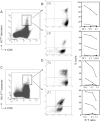Naturally acquired tolerance and sensitization to minor histocompatibility antigens in healthy family members
- PMID: 19506299
- PMCID: PMC3402366
- DOI: 10.1182/blood-2009-01-200410
Naturally acquired tolerance and sensitization to minor histocompatibility antigens in healthy family members
Abstract
Bidirectional cell transfer during pregnancy frequently leads to postpartum persistence of allogeneic cells and alloimmune responses in both the mother and in her offspring. The life-long consequences of naturally acquired alloimmune reactivity are probably of importance for the outcome of allogeneic stem cell transplantation. We investigated the presence of CD8(pos) minor histocompatibility (H) antigen-specific cytotoxic T lymphocytes (T(CTL)) and CD8(pos) minor H antigen-specific T regulator cells (T(REG)) in peripheral blood cells obtained from 17 minor H antigen-disparate mother-offspring pairs. Absence of minor H antigen-specific T(REG), as marked by the feasibility to expand T(CTL) from isolated tetramer(pos) populations, was observed in 6 mothers and 1 son. The presence of minor H alloantigen-specific T(REG) was observed in 4 mothers and 5 sons. These T(REG) were detected within isolated tetramer(dim) staining fractions and functioned in a CTLA-4-dependent fashion. Our study indicates that both T(CTL) and T(REG) mediated alloimmunity against minor H antigens may be present in healthy female and male hematopoietic stem cell donors, potentially influencing graft-versus-host reactivity in different ways.
Figures





Comment in
-
Tolerance: pregnancy matters.Blood. 2009 Sep 10;114(11):2208-9. doi: 10.1182/blood-2009-06-228528. Blood. 2009. PMID: 19745072 No abstract available.
Similar articles
-
Human CD8+ T-regulatory cells with low-avidity T-cell receptor specific for minor histocompatibility antigens.Hum Immunol. 2008 Nov;69(11):728-31. doi: 10.1016/j.humimm.2008.08.289. Epub 2008 Sep 21. Hum Immunol. 2008. PMID: 18812197 Free PMC article. Review.
-
Ex vivo detection of CD8 T cells specific for H-Y minor histocompatibility antigens in allogeneic hematopoietic stem cell transplant recipients.Transpl Immunol. 2014 May;30(4):128-35. doi: 10.1016/j.trim.2014.02.001. Epub 2014 Feb 26. Transpl Immunol. 2014. PMID: 24582729
-
Isolation of human CD4/CD8 double-positive, graft-versus-host disease-protective, minor histocompatibility antigen-specific regulatory T cells and of a novel HLA-DR7-restricted HY-specific CD4 clone.J Immunol. 2013 Jan 1;190(1):184-94. doi: 10.4049/jimmunol.1201163. Epub 2012 Dec 7. J Immunol. 2013. PMID: 23225889
-
Leukemia-associated minor histocompatibility antigen discovery using T-cell clones isolated by in vitro stimulation of naive CD8+ T cells.Blood. 2010 Jun 10;115(23):4923-33. doi: 10.1182/blood-2009-12-260539. Epub 2010 Mar 4. Blood. 2010. PMID: 20203263 Free PMC article.
-
Clinical impact of H-Y alloimmunity.Immunol Res. 2014 May;58(2-3):249-58. doi: 10.1007/s12026-014-8514-3. Immunol Res. 2014. PMID: 24781195 Free PMC article. Review.
Cited by
-
Microchimerism is strongly correlated with tolerance to noninherited maternal antigens in mice.Blood. 2009 Oct 22;114(17):3578-87. doi: 10.1182/blood-2009-03-213561. Epub 2009 Aug 21. Blood. 2009. PMID: 19700665 Free PMC article.
-
Tolerogenic effect of non-inherited maternal antigens in hematopoietic stem cell transplantation.Front Immunol. 2012 May 25;3:135. doi: 10.3389/fimmu.2012.00135. eCollection 2012. Front Immunol. 2012. PMID: 22654885 Free PMC article.
-
Heterogeneity within T Cell Memory: Implications for Transplant Tolerance.Front Immunol. 2012 Mar 1;3:36. doi: 10.3389/fimmu.2012.00036. eCollection 2012. Front Immunol. 2012. PMID: 22566919 Free PMC article.
-
Antigen-specific decidual CD8+ T cells include distinct effector memory and tissue-resident memory cells.JCI Insight. 2023 Sep 8;8(17):e171806. doi: 10.1172/jci.insight.171806. JCI Insight. 2023. PMID: 37681414 Free PMC article.
-
Immune response to a model shared placenta/tumor-associated antigen reduces cancer risk in parous mice.Biol Reprod. 2017 Jan 1;96(1):134-144. doi: 10.1095/biolreprod.116.144907. Biol Reprod. 2017. PMID: 28395331 Free PMC article.
References
-
- van Rood JJ, Eernisse JG, van Leeuwen A. Leucocyte antibodies in sera from pregnant women. Nature. 1958;181:1735–1736. - PubMed
-
- van Kampen CA, Versteeg-van der Voort Maarschalk MF, Langerak J, et al. Pregnancy can induce long-persisting primed CTLs specific for inherited paternal HLA antigens. Hum Immunol. 2001;62:201–207. - PubMed
-
- Verdijk RM, Kloosterman A, Pool J, et al. Pregnancy induces minor histocompatibility antigen-specific cytotoxic T cells: implications for stem cell transplantation and immunotherapy. Blood. 2004;103:1961–1964. - PubMed
-
- Claas FH, Gijbels Y, van der Velden-de Munck, van Rood JJ. Induction of B cell unresponsiveness to noninherited maternal HLA antigens during fetal life. Science. 1988;241:1815–1817. - PubMed
Publication types
MeSH terms
Substances
Grants and funding
LinkOut - more resources
Full Text Sources
Medical
Research Materials

